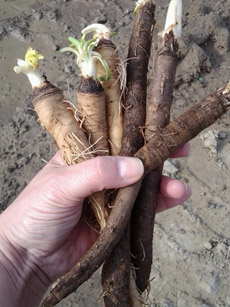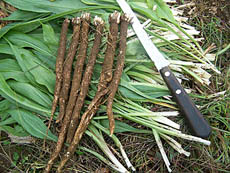TIP OF THE DAY: Salsify
|
We can’t believe that in 15 years of publishing THE NIBBLE, we’ve never published an article on salsify. Ironically, it is known as a “forgotten vegetable.” WHAT IS SALSIFY? Salsify, pronounced SAL-suh-fee OR SAL-suh-fie, is a root vegetable in the Asteraceae or dandelion family. Dandelions, daisies and lettuce are in the family, but belong to different genuses (they’re not root vegetables). Other root vegetables belong to other families entirely: Beetroot (Amaranthaceae); burdock/gobo (Asteraceae); carrot and celeriac/celery root (Apiaceae); (Apiaceae); daikon/white Japanese radish, black radish, horseradish, radish, rutabaga, turnip and wasabi (Brassicaceae); lotus root, parsley root and parsnip (Nelumbonaceae). These roots lack the grace of carrot or parsnip. White salsify is “hairy” and black salsify looks like a twig. White Salsify. White salsify could be mistaken for a thin parsnip, but its flavor has been compared to an artichoke heart or Jerusalem artichoke (sunchoke). Because of its minerality, it has also earned the names oyster plant or vegetable oyster. Because of its purple flowers, some call it purple salsify. Black Salsify. Its cousin, black salsify, has yellow flowers and the flavor of mild asparagus. It was first cultivated in Spain, and is also called Spanish salsify and false salsify. Root vegetables have long been important in the kitchen. After harvesting, they last a good while in the pantry without spoiling, and last even longer in the fridge. In older times, the root cellar kept a family fed through the winter. Different roots have different flavor profiles. Radishes are pungent, carrots are sweet, beets are sweet and earthy. Parsnips, turnips, rutabagas and salsify have more subtle flavors. Root vegetables are also rich in nutrients, low in fat and calories, inexpensive, and in modern times, usually available year-round. The roots have a rough outer skin, which requires scrubbing and, for many people, peeling. (It is fine to eat the skin.) Buy firm roots, preferably with the green tops still on. You can refrigerate them in an airtight container, but use them within a week; the roots alone will last for two weeks. To store, wrap the roots in plastic and refrigerate. Check periodically to see if the root is drying out. If it is, it’s time to cook them! Before cooking, scrub the root under cold running water, peel with a vegetable peeler and immediately place into acidulated water, water with a bit of lemon juice or vinegar to prevent discoloration. After you peel the root, you can cut it into matchsticks or thicker short lengths, or slice them into coins. Simmer for half an hour until soft, drain, and sauté in a bit of butter. |
|
|
|
TYPES OF SALSIFY There are two types of salsify: white salsify and black salsify. The latter is more highly regarded for its nutrition. Now pay attention, because while they’re both members of Asteraceae, the daisy family, they’re actually different species! Both roots are low in sodium and offer a good amount of protein. They contains modest amounts of vitamin C, some B vitamins, and complex carbohydrates.r in the black variety can boost hair health. Both varieties are native to western Eurasia and were originally cultivated for both its root and greens and are grown in the same way. |
||

|
HOW TO SERVE SALSIFY Salsify may not be the best looking root, but it delivers beautiful flavor. It pairs well with butter, cream, garlic and parsley. We’ve included some recipes below. If you find young roots with the leaves attached, the leaves are also quite tasty and can be added to salads, sautés or stir-fries. By the time the roots are mature, however, all but the most inner leaves have grown tough. Black salsify and white salsify are interchangeable in recipes. You can use them for: You can find many salsify recipes, from bruschetta to salsa. This recipe, from Good Eggs in San Francisco (photo left/bottom), takes 10 minutes prep time, 35 minutes total time. |
|
|
Preparation 1. PREHEAT the oven to 350°F. Remove pork chops from their packaging, pat dry and season with salt and pepper. Let the meat come to room temperature. 2. FILL a pot halfway with water. Add a tablespoon of salt and the juice of one lemon; then add the salsify pieces. Cover and bring to a boil; then turn down to a simmer and let cook until very tender, about 25 minutes. While the salsify simmers… 3. THINLY SLICE the spring onion and place it in a small bowl. Cover it with a few splashes of red wine vinegar and set aside. Once the salsify is tender… 4. SCOOP it out of the water into a large bowl. Mash it with a fork, adding a tablespoon or two of butter, a few pinches of salt and a few grinds of black pepper. Mash to your preferred texture. 5. HEAT a cast iron pan over high heat with a bit of olive oil. When the olive oil is hot, add the pork chops and cook until golden brown on one side, about 3-4 minutes. Flip and sear for another 3-4 minutes before moving the entire pan into the preheated oven. Let it cook for about 5 minutes, until the internal temperature measured at the center of the chop reads 140°-145° (for medium rare). Remove from the pan and let rest for 10 minutes. 6. FOLD the herbs into the snap peas with a tablespoon of olive oil and half of the vinegar mixture. Add salt and pepper to taste, and more vinegar to taste. After the chops have rested… 7. SLICE into ½ inch slices and divide between two plates. Serves alongside a few dollops of the salsify and cover the salsify and pork chops with a few generous spoonfuls of herbed snap peas.
|
||







